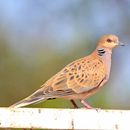Biology
provided by Arkive
Adults feed on the ground, mainly on cereal and wildflower seeds and the occasional insect. During the first five days of life the young are fed on 'crop-milk' which the parents regurgitate. They then eat small seeds and insects.
Turtle doves return from their wintering grounds around late April and immediately start nesting. The nests are usually made in hedges or scrub, two broods may be produced in the season each consisting of two eggs. Both parents share the incubation and feeding duties (2).
Conservation
provided by Arkive
Little conservation action has been targeted at the turtle dove, as it was not recognised as a species for conservation concern until recently (3). Agri-environment schemes, such as the Countryside Stewardship Scheme, should benefit this species by encouraging the retention of winter stubble fields. The turtle dove is a priority species under the UK Biodiversity Action Plan (UK BAP); the plan aims to halt the decline by 2003 and promote a sustained recovery (3).
Description
provided by Arkive
This small, delicate dove is slightly larger than a blackbird. It has dark black and chestnut upper parts with a white belly and pink breast. The flight is characterised by flickering wing beats interspersed by short glides. The scientific name turtur comes from the soft 'turr turr' call (2).
Habitat
provided by Arkive
Mainly found in lowland agricultural land with copses, large hedgerows, and orchards near to cereal or weedy fields. Dry sunny habitats are preferred but it can also be found on heathland, and in gardens and parks (2).
Range
provided by Arkive
The turtle dove is a widespread summer migrant throughout Europe, common in the central and southern European lowlands (2). The UK is the northern edge of its range, where it is found mainly in the south and east. This species spends the winter in sub-Saharan Africa (2).
Status
provided by Arkive
Listed on the Birds of Conservation Concern Red List and Annex II of the EC Birds Directive. Protected in the UK under the Wildlife and Countryside Act 1981 (3).
Threats
provided by Arkive
The UK population of turtle doves fell by 60% between 1966-72 and 1988-91. At the same time many other farmland bird species also suffered massive declines. The reasons for these declines are thought to be the widespread changes in agricultural practices that have occurred since the Second World War. These changes include the increased use of herbicides and pesticides, reducing food availability, and the removal of hedgerows and scrub which has removed nesting sites. Further threats to this species occur outside the UK on the long migration to Africa and after arrival. It is shot in huge numbers during migration through France, Spain and Morocco and in the wintering grounds mainly in Senegal (3).

